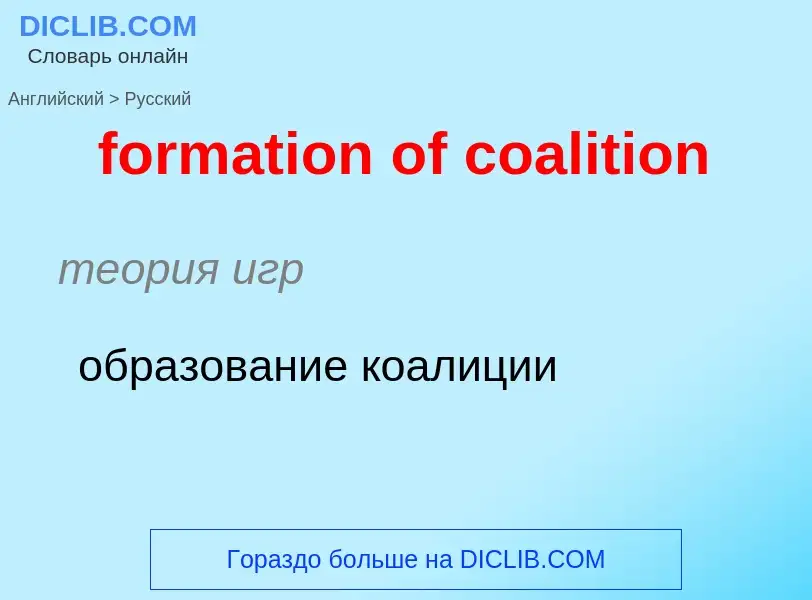Перевод и анализ слов искусственным интеллектом ChatGPT
На этой странице Вы можете получить подробный анализ слова или словосочетания, произведенный с помощью лучшей на сегодняшний день технологии искусственного интеллекта:
- как употребляется слово
- частота употребления
- используется оно чаще в устной или письменной речи
- варианты перевода слова
- примеры употребления (несколько фраз с переводом)
- этимология
formation of coalition - перевод на русский
теория игр
образование коалиции
общая лексика
коалиционное правительство
[,kəuə'lɪʃtn,gʌvnmənt]
общая лексика
коалиционное правительство (объединяет различные политические партии; в 20 в. существовали буржуазные коалиционные правительства Г.Асквита [H.H.Asquith] в 1915-16, Д.Ллойд Джорджа [D.Lloyd George] в 1916-22, Р.Макдональда [R.Mac-Donald] в 1931-35 и У.Черчилля [W.Churchill] в 1940-45)
общая лексика
теплота образования
- customer coalition
- disjoint coalitions
- indecomposable coalition
- losing coalition
- potential coalition
- winning coalition
[kəuə'liʃ(ə)n]
общая лексика
союз
коалиционный
соединение
сочетание
этология
коалиция
существительное
общая лексика
коалиция
союз (временный)
союз (временный)
коалиционный
синоним
Определение
.
Википедия

The War of the First Coalition (French: Guerre de la Première Coalition) was a set of wars that several European powers fought between 1792 and 1797 initially against the constitutional Kingdom of France and then the French Republic that succeeded it. They were only loosely allied and fought without much apparent coordination or agreement; each power had its eye on a different part of France it wanted to appropriate after a French defeat, which never occurred.
Relations between the French revolutionaries and neighbouring monarchies had deteriorated following the Declaration of Pillnitz in August 1791. Eight months later, following a vote of the revolutionary-led Legislative Assembly, France declared war on Austria on 20 April 1792; Prussia, having allied with Austria in February, declared war on France in June 1792. In July 1792, an army under the Duke of Brunswick and composed mostly of Prussians joined the Austrian side and invaded France. The capture of Verdun (2 September 1792) triggered the September massacres in Paris. France counterattacked with victory at Valmy (20 September) and two days later the Legislative Assembly proclaimed the French Republic.
Subsequently, these powers made several invasions of France by land and sea, with Prussia and Austria attacking from the Austrian Netherlands and the Rhine, and the Kingdom of Great Britain supporting revolts in provincial France and laying siege to Toulon in October 1793. France suffered reverses (Battle of Neerwinden, 18 March 1793) and internal strife (War in the Vendée) and responded with draconian measures. The Committee of Public Safety was formed (6 April 1793) and the levée en masse drafted all potential soldiers aged 18 to 25 (August 1793). The new French armies counterattacked, repelled the invaders, and advanced beyond France.
The French established the Batavian Republic as a sister republic (May 1795) and gained Prussian recognition of French control of the Left Bank of the Rhine by the first Peace of Basel. With the Treaty of Campo Formio, the Holy Roman Empire ceded the Austrian Netherlands to France and Northern Italy was turned into several French sister republics. Spain made a separate peace accord with France (Second Treaty of Basel) and the French Directory carried out plans to conquer more of the Holy Roman Empire.
North of the Alps, Archduke Charles, Duke of Teschen redressed the situation in 1796, but Napoleon Bonaparte carried all before him against Sardinia and Austria in northern Italy (1796–1797) near the Po Valley, culminating in the Peace of Leoben and the Treaty of Campo Formio (October 1797). The First Coalition collapsed, leaving only Britain in the field fighting against France.


![The British evacuation of [[Toulon]] in December 1793 The British evacuation of [[Toulon]] in December 1793](https://commons.wikimedia.org/wiki/Special:FilePath/Les coalises evacuent Toulon en decembre 1793.jpg?width=200)
![The [[Glorious First of June]], 1 June 1794 The [[Glorious First of June]], 1 June 1794](https://commons.wikimedia.org/wiki/Special:FilePath/Loutherbourg-La Victoire de Lord Howe.jpg?width=200)
![Napoleon at the [[Battle of Rivoli]], 14 January 1797 Napoleon at the [[Battle of Rivoli]], 14 January 1797](https://commons.wikimedia.org/wiki/Special:FilePath/Napoleon at the Battle of Rivoli.jpg?width=200)

![[[Sigmar Gabriel]] (SPD), [[Angela Merkel]] (CDU) and [[Horst Seehofer]] (CSU) presenting the 2013 coalition agreement for Germany's [[third Merkel cabinet]]. [[Sigmar Gabriel]] (SPD), [[Angela Merkel]] (CDU) and [[Horst Seehofer]] (CSU) presenting the 2013 coalition agreement for Germany's [[third Merkel cabinet]].](https://commons.wikimedia.org/wiki/Special:FilePath/Unterschrift des Koalitionsvertrages der 18. Wahlperiode des Bundestages.jpg?width=200)
